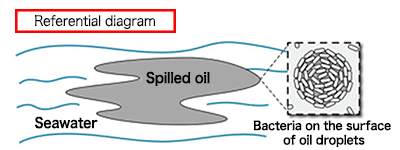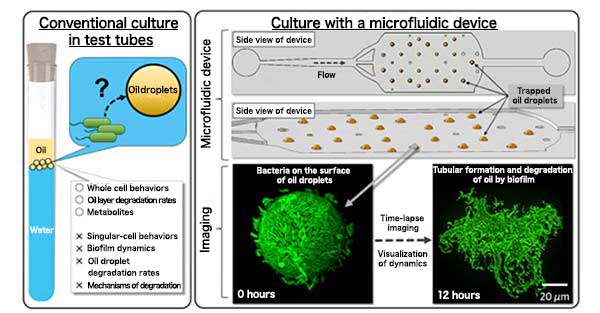Research Results
Elucidation of Biofilm Mechanisms
Biofilms Formed by Oil-Degrading Marine Bacteria Efficiently Degrades OilFY2025

- NOMURA Nobuhiko (Professor, Institute of Life and Environmental Sciences, University of Tsukuba)
- ERATO
- Research Director (2015-2021) “ERATO NOMURA Microbial Community Control Project”
Elucidation of the mechanism of bacterial oil degradation
In the environment surrounding living organisms, many bacteria form communities called biofilms*1. Certain species of bacteria found widely in the ocean break down oil and other substances spilled into the ocean and use them as a source of nutrition. It is known that these bacteria form biofilms around oil droplets (Fig. 1). However, the mechanism of biofilm formation and the relation between biofilms and oil degradation, or how biofilms degrade oil, remained unknown.
In this research, the research group used a microfluidic device*2 to visualize the spatiotemporal dynamics of the interaction between bacteria and minute oil droplets at high resolution. This led to the discovery that marine oil-degrading bacteria aggregate into communities, firmly adhering to the oil-water interface and subsequently growing, thereby causing curvature at the interface. Such curvature expansion increases the surface area of the oil-water interface, facilitating direct contact between bacterial cells and oil, thereby enhancing oil degradation efficiency. These findings elucidate a mechanism underlying microbial oil degradation and are expected to contribute to advancing bacterial-based environmental remediation technologies.
*1 Biofilm
An aggregate formed by microorganisms. It is composed of microbial cells and matrices (e.g., polysaccharides, proteins, nucleic acids) produced by microorganisms themselves.
*2 Microfluidic device
A device that uses microfabrication technologies to form microfluidic channels on resin, glass, and other substrates.

Fig.1 Schematic Diagram of Bacteria on the Surface of Oil Droplets in the Seawater
The mechanism of biofilm formation in the real-world environment remains unclear
Many bacteria survive by forming communities known as biofilms. Biofilms have significant impacts on plants, animals, and human health and daily life. They cause serious infections and lead to substantial economic losses due to clogging and corrosion of industrial pipes. On the other hand, biofilms also plays an important role in wastewater treatment and are recognized as key agents of bioremediation.
Among marine bacteria, some species use petroleum as a nutrient source, enabling them to degrade oil spilled into the ocean. They are known to form biofilms around oil droplets during the degradation process; however, the mechanisms underlying biofilm formation and the detailed processes by which they degrade petroleum have remained unclear.
Unraveling the biofilm mechanisms using a microfluidic device
Previous research investigating the mechanisms by which oil-degrading marine bacteria form biofilms and degrade oil has primarily been conducted using test-tube experiments, yet these studies have not successfully elucidated the underlying processes. (Fig. 2, left). In the present study, the research group utilized a microfluidic device capable of trapping oil droplets approximately half the diameter of a human hair and continuously observing the behavior of oil-degrading marine bacteria (Alcanivorax borkumensis) on these droplets for over one week. (Fig. 2, right).
Observation results showed that A. borkumensis forms two distinct types of biofilms on oil droplets. The research group named these two types "spherical biofilm" (SB) and "dendritic biofilm" (DB).
Since oil and water do not mix, oil droplets usually maintain a spherical structure in seawater. SB merely encapsulates oil droplets in a spherical form, whereas DB actively increases the oil-water interface area, leading to significantly faster degradation of oil droplets compared to SB. When A. borkumensis degrades oil, it forms DB at the oil-water interface, disrupting the interface structure and transforming the oil droplets into a dendritic shape. This transformation exponentially increases the oil-water interface area, allowing more bacterial cells to directly contact the oil.
To clarify how DB cells deform oil droplets, the research group investigated the properties of the cell surface. The results revealed that the surface of DB cells is more hydrophobic than that of SB cells, enabling stronger adhesion to oil. A. borkumensis also secretes molecules known as biosurfactants*3, which reduce surface tension and deform the oil-water interface, further expanding its surface area.
Furthermore, the research group employed a theoretical physical model to predict the formational dynamics and shapes of biofilms. The results indicated that bacterial cells fully cover the oil droplet surface, displaying characteristic arrangement patterns that can be explained by liquid crystal physics (an intermediate state between solid and liquid phases).
The deformation of oil droplets was observed to originate from the center of region where cells are arranged in patterns resembling the petals of a wild chrysanthemum (Fig. 3). As the pressure in biofilms increases due to bacterial growth and cell density, the central region protrudes, initiating the formation of dendritic structures. This phenomenon occurs because individual bacterial cells cooperate within the biofilm, concentrating the pressure generated by cell growth at specific points, thus deforming the oil-water interface. As a result, oil tubes covered with bacterial cells are formed. The arrangement of bacterial cells was found to be similar to that of the nematic phase of liquid crystal, wherein molecular long axes are uniformly oriented in one direction, while molecular positions remain random.
*3 Biosurfactant
Surfactants produced by microorganisms that reduce interfacial tension between oil and water, thus allowing these normally immiscible liquids to mix.
*4 Confocal laser scanning microscopy
A microscopy technique that produces high-resolution, three-dimensional images by scanning a laser beam across the surface of the specimen.

Fig.2 Technology to Observe Bacteria on Oil Droplets Using Microfluidic Device

Fig.3
Images of a Spherical Biofilm and Dendritic Biofilm on an Oil Droplet Using Confocal Laser Scanning Microscopy*4
The oil droplet in SB remains spherical but dendritic shape in DB, extending into tubular structures. The figure on the right shows the arrangement of bacterial cells on the oil droplet immediately before protrusion occurs. The inserted image shows a photograph of a wild chrysanthemum. The protrusion of oil droplets begins from the area corresponding to the center of the wild chrysanthemum.
Toward the next-generation fundamental technologies for controlling and efficiently utilizing microorganisms in the real-world environment
In recent years, much attention has been focused on the complex behavior exhibited by materials capable of autonomous motion, known as active matter. Bacteria are one such "matter" and have been historically known to be equipped with special abilities that we humans do not have. The research demonstrated that bacteria efficiently utilize their food source, oil, through mechanisms governed by physical principles. Such mechanism can be applied to research on other similar organisms and may contribute to the optimization of oil bioremediation*5.
*5 Bioremediation
A technology that uses microorganisms, plants, and other living organisms to purify soil, groundwater, and oceans contaminated with toxic substances.
- Life Science
- Research Results
- Japanese
